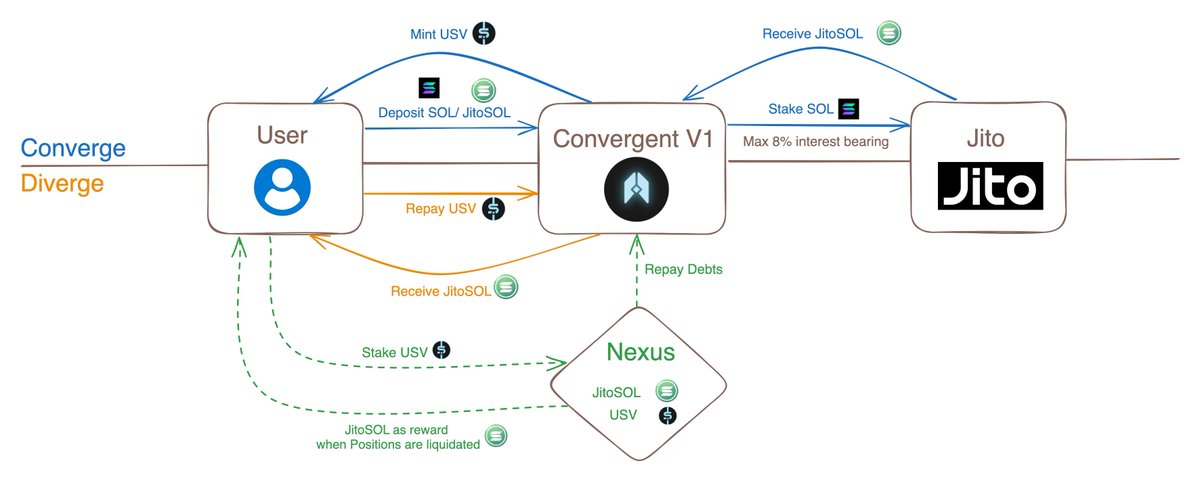Recently, the research team has been exploring innovative projects on the #SOL chain, moving away from outdated concepts and focusing on recent hot topics like #Payfi, #RWA, stablecoins, etc. They have indeed discovered an interesting project, an algorithmic stablecoin project, which is quite intriguing. The project currently does not have a token, and the rumored contract address has not been officially confirmed, so please be cautious about risks and security; this is only for research observation.
Convergent Protocol (@convergent_so) aims to create a truly decentralized algorithmic stablecoin on Solana called USV. We all know that the stablecoin market is dominated by centralized entities like USDC and USDT, which, while convenient, often give a feeling of "having your lifeline in someone else's hands." #Convergent wants to change this situation, allowing the Solana ecosystem to have a more independent, censorship-resistant, community-driven stablecoin. At the same time, it aims to make your SOL work more efficiently to "generate money."
Let’s break it down in simple terms, as algorithmic stablecoins can be quite complex:
First, what is the stablecoin called #USV?
The target price is 1 dollar: USV is pegged to the US dollar at a 1:1 ratio.
How does it maintain the 1 dollar peg? Through an algorithmic mechanism, not relying on centralized entities: If USV falls below 1 dollar (for example, 0.9 dollars): The system will encourage people to buy cheap USV in the market and then burn it. By burning USV, you can redeem your previously collateralized assets at a discounted price. This reduces the supply of USV, causing the price to rise back towards 1 dollar.
If USV rises above 1 dollar (for example, 1.1 dollars): The system will increase the cost of minting new USV (for example, requiring more collateral), making people less inclined to mint new USV, which decreases demand and gradually brings the price back to 1 dollar.
The core is that it does not rely on USDC, which is quite interesting! This project emphasizes that it does not need centralized assets like #FRAX or #DAI (which initially relied on USDC) to maintain stability. Instead, it uses a set of incentive and penalty mechanisms for dynamic adjustment, making it more pure.
Benefits of USV: 0% interest loans, over-collateralization, your liquid staking yield (LSD yield) is not charged, completely decentralized, censorship-resistant, and can be combined with other DeFi Lego blocks.
How do users play? How do they make money?
Deposit SOL, borrow USV (0% interest): By collaborating with #Jito, you can collateralize your SOL (mainly JitoSOL, which is yield-bearing SOL) in the Convergent Protocol and then borrow the stablecoin USV at 0% interest (it’s unclear how this is achieved, whether through early subsidies or something else)!
In any case, this is quite appealing. Your SOL is still working for you: The SOL you collateralized (JitoSOL) will automatically earn staking rewards and MEV rewards on Solana. Essentially, your principal is still at work.
Uses of #USV: The borrowed USV can be used in other DeFi projects within the Solana ecosystem, such as for leverage, providing liquidity (LP), lending, etc.
Nexus system: You can deposit USV into a place called Nexus, where you can earn liquidation-generated profits and mine their future governance token $CVGT. The future V2 version will be even more powerful: Looking at the V2 diagram, there will be more interactions between users, SOL, and USV. It also introduces something called AMO (Algorithmic Market Operations Controller), which will automatically balance prices in the USV/USDC pool when USV is above 1 dollar. Users can also stake CVGT tokens to earn protocol fees.
What are AGENTS NFT and FRAGMENTS?
AGENTS J (NFT): This is their genesis NFT series. In simple terms, it is a way for the project team to attract early core users, build a community, and connect with valuable investors/DAO organizations before the project officially launches. Holders of this NFT may receive airdrops, whitelist opportunities, or other benefits in the future. They have also listed many collaborating NFT projects.
FRAGMENTS (points system): Before the official issuance (TGE) of their token $CVGT, they have set up a points system.
How do you earn points? For example, by staking your AGENTS NFT, using their dApp, or meeting some (currently not fully disclosed) criteria for retrospective airdrops. These points will be exchanged for their $CVGT tokens at a certain ratio in the future. This is a common early user incentive and community engagement method, encouraging participation and contribution in the early stages of the project.
Overall, it is quite an interesting project. A decentralized algorithmic stablecoin is one of the holy grails of #DeFi, especially in a public chain ecosystem where having a native, robust decentralized stablecoin is crucial. The #Solana ecosystem indeed needs such a role; let’s see if it can emerge. It is said to be a fair launch, and currently, there is no official contract address, so please pay attention to safety and wait for official updates. Any new project comes with uncertainties, and the team's execution ability, technical implementation, and market acceptance need time to be tested. Everyone should DYOR and not rush blindly. You can keep an eye on the project’s subsequent developments, especially the progress of the NFT and points system, as well as the actual performance after the final product launch. 🧐 Purely for research, not for promotion.

免责声明:本文章仅代表作者个人观点,不代表本平台的立场和观点。本文章仅供信息分享,不构成对任何人的任何投资建议。用户与作者之间的任何争议,与本平台无关。如网页中刊载的文章或图片涉及侵权,请提供相关的权利证明和身份证明发送邮件到support@aicoin.com,本平台相关工作人员将会进行核查。



